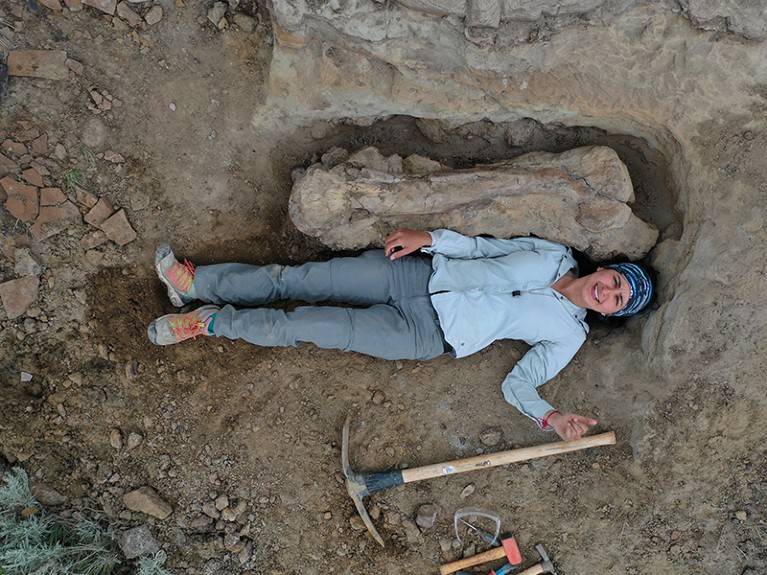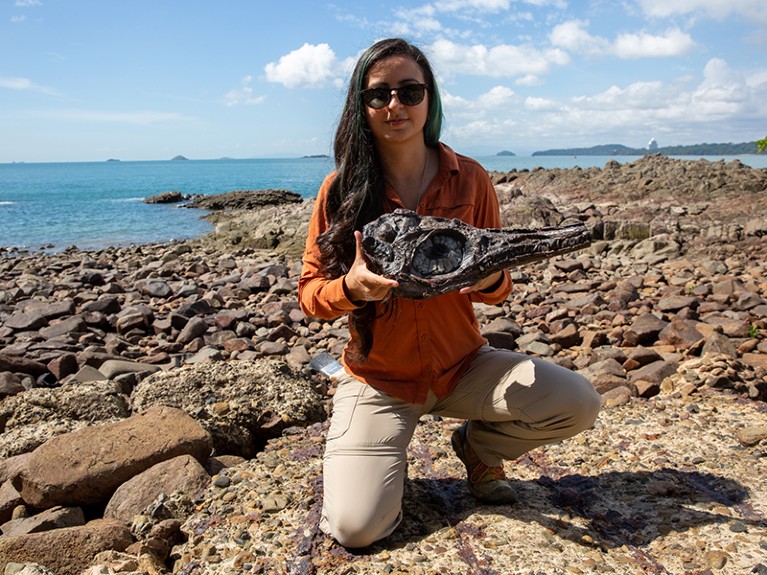
PhD candidate Dirley Cortés lies next to a therapod dinosaur’s long bone during a field course at the Dinosaur Provincial Park near Brooks, Canada.Credit: Hans Larsson/McGill University, Canada
Born and raised in Villa de Leyva, Colombia, Dirley Cortés used to come home from family walks with her pockets full of rocks from the fossil-rich area around her small hometown. Her family, full of fossil collectors and preparators, used those rocks to inspire her to keep asking questions about how the world works.
Now a PhD candidate at McGill University’s Redpath Museum in Montreal, Canada, Cortés investigates the structures of food chains in marine ecosystems from the Cretaceous period. She is also the scientific director of the Paleontological Research Centre in Villa de Leyva, a non-profit institution that studies fossils from the Paja Formation, located in central Colombia.
Villa de Leyva sits atop the formation, a band of sedimentary rocks that accumulated during the Early Cretaceous period from 130 million to 115 million years ago, a time when Earth had a warmer climate, Iguanodon and Padillasaurus walked on land and large marine reptiles such as Kyhytysuka sachicarum were apex predators in the oceans. Cortés tells Nature about the challenges that she has faced as a Latina working in academic palaeontology, and how she has navigated them as an early-career researcher.
What motivated you to become a scientist?
What sets a scientist apart is that they stick with the question, to dig deeper and try to find answers. In Villa de Leyva, I was always surrounded by fossils and rocks. When I got home with my pockets full of my finds, I was curious to know what they were and how they came to be in this place. It was interesting to read and learn that the planet was very different a long time ago. I read Journey to the Center of the Earth by Jules Verne, and that made me even more intrigued and fascinated by the mysteries beneath our feet.
When did your interests turn to palaeontology?
In secondary school, one of my teachers loved the idea of me doing a research project in palaeontology. My family had collected the fossilized jaw of a pliosaur, so my best friend and I decided to try to understand what a pliosaur was — a large, carnivorous marine reptile — by preparing the jaw and showing how we could remove the rock covering the bone to understand the creature’s anatomy. We also built a concrete model of a therapod dinosaur and donated it to the school, to spark interest among the students.

Cortés holds a cast of an ichthyosaur (Muiscasaurus catheti) skull while teaching in Panama City.Credit: Jorge Alemán/Smithsonian Tropical Research Institute, Panama
Your family has long been involved in palaeontology, but you are the first to pursue a professional research career in the field. What does that mean to you?
It’s an enormous privilege. It also comes with a sense of responsibility. I’ve received so much from Colombia and my hometown — I have to give back in some way. It’s such a beautiful and magical place.
I’ve had the opportunity to connect with a growing network of palaeontologists, scientists and scholars in Colombia, and that creates a shared mission. We feel that it’s crucial to advance science in the country — Colombians need a better basic understanding of science, from primary-school students to undergraduates and even to professionals, including those facing the public, such as politicians. My colleagues and I are currently working with the local government to develop a public-policy programme in palaeontology, to help this field to flourish in the region.
What challenges have you faced as a Latina palaeontology student?
Academia carries many biases. Historically, it has been elitist, classist and sexist, and many parts of it still are. Being part of a community of Latin American women in science is important to me. I’ve found that doing science is the ultimate act of rebellion, and a way to confront the injustices that women face every day.
I think researchers from a country such as Colombia might be labelled with stereotypes — the Colombian passport always carries extra weight, because of the country’s social and political history.
Latina women, women of colour and female scientists can generate discomfort in those entrenched in the status quo, which is a good sign because it means we are breaking glass ceilings. It means we are filling spaces that were not intended for women like us.
I’ve faced situations in the field in which women are expected to cook or help in the kitchen, but aren’t asked to drive the vehicle or carry heavy things. To push back, women can do the opposite of what they’re expected to do — occupy those spaces, break down those barriers and rewrite the narratives.
What else can women do to navigate these challenges?
The first thing is to speak up. Understanding that it’s not a battle that falls solely on one person, but one that resonates with all of us. Together we can achieve more; if one person falls, we can help to lift her up. The most important thing has been to create support networks, engage in discussions, understand that there are situations in which we shouldn’t be submissive and work out how to face instances of patriarchy.
It has been crucial for me to find female role models. For instance, meeting other Colombian palaeontologists, such as Mónica Carvalho at the University of Michigan in Ann Arbor and Catalina Pimiento at the Paleontology Institute and Museum at the University of Zurich, Switzerland, has been very important for me. Their research has contributed to our understanding of what tropical forests looked like during the dinosaurs’ time, and to unravelling the biological history of the megalodon (Otodus megalodon) to understand when and why it became extinct. They have shown me that women can do amazing things.
What would you say to other early-career women from Latin America starting on this path?
I’d tell them it’s possible, but only if they don’t romanticize science and they actively work to achieve social justice in what they do. Doing science comes with a huge responsibility, and wherever you are, you’re breaking barriers. It’s possible, but it’s not easy.
Being part of networks of women who work daily to tackle these challenges is crucial. Outside Latin America, we might seem like oddities — but our presence challenges patriarchal norms, and that affects the world outside our research. It shifts the culture of science to be more equitable. We’re like little ants fulfilling a bigger role in the colony. Looking at your position that way can help you to savour situations that aren’t comfortable.
What are your future plans?
For now, the next step is to keep studying the biota of the Paja Formation and delve deeper into how ancient seas and ecosystems functioned and how that applies to today’s marine ecosystems.
I’m currently looking for postdoc positions. My plan is to learn about new research methods, explore new areas and time scales and ask new questions. I’ll also stay connected with the Paleontological Research Centre and the network of palaeontologists in Colombia and Latin America. My ultimate goal is to keep contributing to the mission of scientific development in Colombia through palaeontology and public outreach.

 Facing racism in science, ‘I decided to prove them wrong’
Facing racism in science, ‘I decided to prove them wrong’
 Promoting palaeontology across Sudan
Promoting palaeontology across Sudan
 What it means to practise values-based research
What it means to practise values-based research







